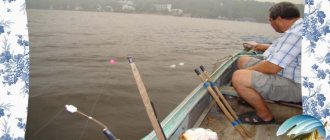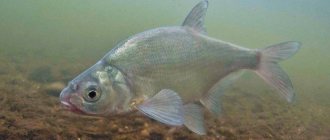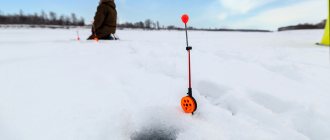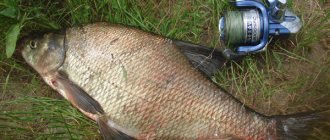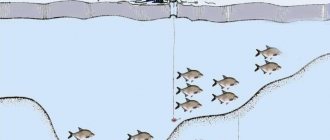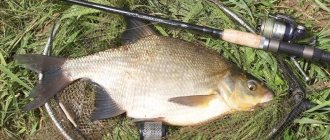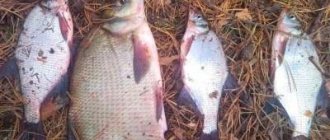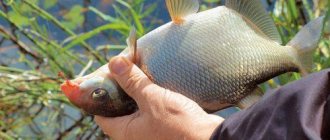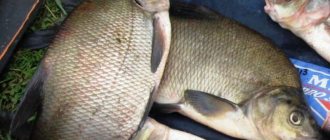Bream has long been considered a worthy catch for a fisherman, whose measure of skill was the capture of especially large trophies of this cautious and cunning fish. Fishing places are not always accessible for comfortable fishing from coastlines and anglers have to look for schools of bream far from land, where bream are more relaxed and active, without fear for their safety. Catching bream from a boat with onboard fishing rods under such conditions becomes the most productive method of hunting, but to ensure it requires an individual selection of equipment both for the fishing itself and for its technical support.
Fishing conditions dictate the approach to choosing the type of gear that allows you to fish conveniently and effectively, regardless of weather conditions. At the same time, the fisherman must understand the basics of anchoring a boat and have all the necessary equipment for this. An important success factor is also bait and bait, which allows you to reliably place a school of fish on a feeding point.
We will talk about all of the above nuances of carrying out a fishing session with onboard rods for catching bream during the course of our article, dwelling in more detail on the significant moments of the process, so that it is easier for the fisherman to organize fishing and spend it with pleasure and adding another solid result to his track record.
Choosing a fishing spot
The choice of fishing location is determined by the habits of the fish, which loves places remote from human activity with a bottom topography suitable for habitation. Basically, schools of bream live in large rivers and lakes, preferring depths of three meters with a clay and hard bottom. Various kinds of underwater ditches and pits attract fish with the possibilities of shelter in the depths and access to food, on the slopes of the edges of these anomalies. Similar conditions can exist on a river with a fast current and on a lake with standing or slow flowing water.
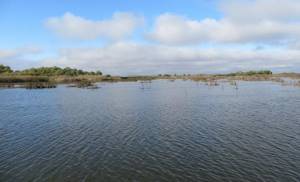
Nowadays, the easiest way to search is to use echo sounders, followed by marking suitable points in the navigator’s memory. If there are no such possibilities, then beacons or buoys secured with weights to the bottom of the reservoir are used to mark places. In this case, the bottom topography is examined using a marker rod. Having decided on a promising point, the angler must worry about attracting fish to the fishing zone, and sometimes this process is carried out for several days, and directly anchor at a distance that allows you to comfortably deliver the bait to an organized feeding table. Fishing with an onboard float rod for bream is carried out from low-speed rubber and PVC boats, which practically do not make a sound due to the impact of waves on the sides and the movement of the fisherman in the boat, thereby not alerting the bream and not scaring away the entire flock with the sound.
Autumn fishing
It should be noted that bream fishing is mainly carried out in the summer. In autumn, the fish move closer to the wintering holes, so it becomes more difficult to find them. However, experienced fishermen usually know the places where they stop in autumn, and they should be guided by them when choosing a place.
And of course, you should adhere to the fact that in the fall bream prefer animal baits to plant baits. Therefore, the following baits are in use:
- worms;
- maggots;
- caddisfly;
- bloodworm;
- salo.
Anchoring a boat
The fundamental point of fishing is proper anchoring of the boat.
Important! The watercraft must be securely anchored at a certain point in the water area, regardless of the forces of current and wind.
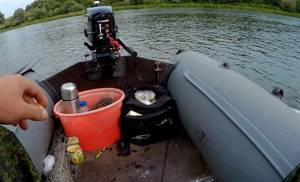
To do this, the boat must be equipped with two anchors with a reliable, at least a centimeter thick, synthetic rope in a length of about 20 meters each. The boat is secured with guy ropes, placing anchors along the stern and bow of the vessel, adjusting stability by pulling the ropes. With this anchoring, the boat becomes side to side with the current and allows you to comfortably position fishing equipment, and landing fish to the boat is easier than trying to take a trophy from the stern or bow of the vessel. The method for calculating the mass of anchors is based on the carrying capacity of the boat and the magnitude of external forces of influence, current and wind.
Important! It is recommended to make anchors with a mass reserve of 25–30% to completely eliminate the possibility of pulling the boat under the influence of increased wind load.
Landing net for catching bream from a boat
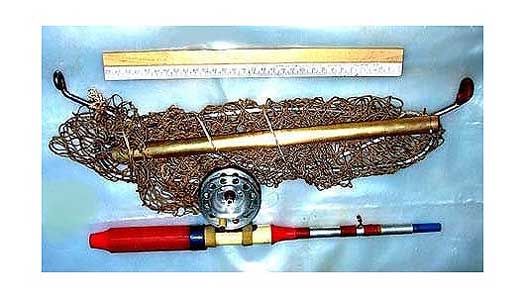
The complete set of a triangular landing net, convenient for catching bream from a rubber boat with side bottoms, is shown in the picture. In this form, my homemade landing net is transported in a backpack.
As you can see, when folded, a folding fishing landing net, which you cannot do without when catching large bream with side rods from a boat, takes up very little space, and making a compact fishing device is easy for any fisherman.
When fishing for bream, the landing net with the handle facing upward is located behind the back, that is, between the seat and the stern of the rubber boat. Thanks to the triangular shape of the frame, the compact fisherman's assistant does not fidget behind his back while fishing or when changing the place of catching bream. Yes, and a landing net was once invented specifically for fishing from a boat.
I recommend tying long (50-70 cm) leashes to the rigging of side donks. Then there is a greater chance that the bottom sinker will not get tangled, falling through the mesh cells when lifting a large bream into the boat using a landing net.
To catch bream from a stationary boat or from the shore, when making a landing net, I recommend lengthening all sides of the so-called head by 5 centimeters, and you can insert a round wooden guide of any reasonable length into the cavity of the tube.
A metal tube that is hollow inside allows you to extend the handle, then the landing net can be used to catch bream from the shore if you do not use a boat when fishing.
Onboard fishing rod for bream
This type of gear is characterized by its miniature size, light weight and ease of assembly. At the same time, the fishing rod must have high strength parameters and positive buoyancy, so as not to be irretrievably lost if it falls overboard.
Important! Carbon fiber options with a massive cork butt fit the base of the side most ideally.
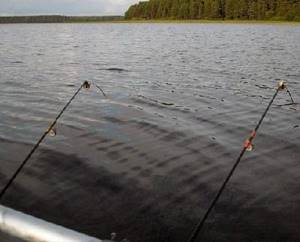
As a rule, tackle like winter spinning rods or their full analogs, no more than one and a half to two meters long, are used as a fishing rod. Blanks are preferable to soft action, with tests no higher than 30 grams. It is advisable to select reinforced guides with a large diameter, which will facilitate comfortable casting and prevent line tangles. Both solid versions and telescopic models of fishing rods are suitable for arranging tackle. The presence of a carbine on the butt of the tackle for insurance is welcome, since the pulling of the fishing rod by a pecked trophy, as well as the elementary dumping into the water during strong waves, is a fairly common phenomenon for this type of fishing, requiring measures to minimize them.
Design and equipment of the onboard fishing rod
The rigging scheme of an onboard fishing rod for bream does not differ much from a regular fishing rod, but it has certain nuances in the configuration of the tackle according to the parameters of some accessories, which makes fishing in cramped conditions on a boat and with constant roughness of the water surface more convenient. Next, we will look at some features of the design and equipment of the flange, based on the method of using fishing installation diagrams, focusing on the main elements of the gear.
Simple float rod
A reel is installed on the base to store fishing line, the volume of which is 20 meters is always sufficient under any fishing conditions. In some cases, and especially in a well-fed spot where the fish stays with enviable constancy, the reel can be eliminated from the design of the tackle by attaching an already known size cut of cord directly to the tip of the rod through a connector or directly. A 0.2 mm fishing line will ensure reliability when catching even a large specimen. Floats are used with a cone-shaped main body and a thin antenna with a bright boss of 10–15 cm. It is more practical to use a float with two points for blind fastening. The float mass range, depending on the strength of the wind and waves, is used in the range from 1 to 5 grams. The sinker is placed sliding, in the shape of an olive, in a single version. The leash is attached directly to the main fishing line, tightly tying the two bases. The leader material is made of monofilament of 0.12-0.16 mm, no more than 30 cm long. Depending on the nozzle, hooks are used in a color similar to it, using different lengths of the forend and focusing on selection in the ranges from 10 to 14 numbers.
Float rod with reel
This option differs from conventional float tackle in the installation of a reel. To a greater extent, the reel will serve as a storage line for the line, allowing you not to retie the main cord when changing the fishing point. For these purposes, lightweight plastic versions of inertial reels of small diameters, with a locking system and a ratchet, are selected. The rod is based on blanks up to two meters in length with guide rings. The principle of the rest of the installation is completely identical to the equipment of a conventional float described above. When assembling the tackle, it is worth considering that the excess weight of the reel and its ability to submerge under water can affect the overall buoyancy of the tackle, making it not a positive characteristic at all.
Rigging a side fishing rod for bream with a nod
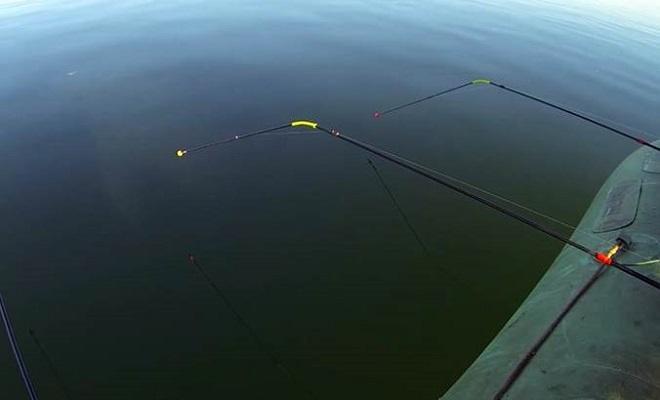
Equipping an onboard fishing rod of this type involves the absence of a float and the use of a nod mounted on the tip of the tackle as a bite alarm. The tackle itself can be designed according to the principle of a float fishing rod. As nods, its elongated Mylar models with a large boss at the tip of the accessory are used for a more expressive demonstration of the bite, which is easy for the angler to notice even if he is distracted by other things with his peripheral vision. The nods themselves should be quite rigid in order to maintain the force of the tensioned fishing line without creating the illusion of false bites. The length of the nod, depending on wind loads and the depth of the bait, varies from 7 to 20 cm.
Bottom fishing rods for onboard fishing
Fishing for bream with an onboard fishing rod from a boat can also be done directly on a certain piece of fishing line wound on a reel with the bait lowered to the bottom, the so-called simple donka. The cord used is a monofilament line from 0.2 to 0.25 mm in diameter. At the end of the thread, on the dead end, a lead flat weight is mounted, the mass of which should hold the equipment at the bottom. Along the length of the cord, leashes from 0.15 mm thick are placed, alternating 50–80 cm. The length of the leash does not exceed 25 cm. For particularly strong currents, the leashes are equipped with a couple of tenths of a gram, approximately half the length of the thread. The installed installation is attached to the side of the boat and equipped with a bell or its electronic equivalent, which will act as a guard.
Bottom fishing rods with feeder equipment for onboard fishing
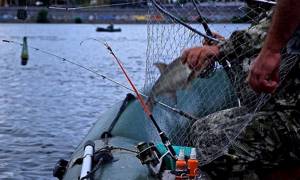
This modern type of bottom fishing is carried out with the help of short and slow casts, using metal mesh feeders of rectangular shapes. To give the installation sensitivity, as well as versatility when tying equipment, a Gardner loop is used, which effectively transmits bites and at the same time is quite resistant to twisting and tangling of equipment when working with a hook in cramped conditions. Bites are determined by working out the quivertype, initially determining its amplitude of movement from waves and the rocking of the boat under the influence of the wind. It is more effective to use thin braids as the main cord, no higher than 0.12 mm in diameter. Leashes are used from monofilament of 0.1-0.12 mm, no longer than 15 cm.
Hair rig on side rod
Hair rigs are used exclusively for bottom fishing for bream, using single boilies or their garlands as bait. The hair rig is mounted identically to the carp rig using a hook with an extended shank, a silicone pressure tube and soft synthetic hair, closed with a stopper. The bait is placed on the bottom in a direct feeding spot or next to the feeder on the hard soil of the bottom of the reservoir.
Feeding process
I use millet porridge as the main component of bait. When cooking porridge, I add a little sunflower cake or crushed roasted seeds, a little salt and a teaspoon of sugar. The porridge should be crumbly. After finishing cooking, I wrap the saucepan in a padded jacket and it turns out that the porridge for the bream ends up still hot when fishing. As additives to it I use store-bought bait “Trapper” or “Dragon”. Previously, when these baits were not available, I added breadcrumbs and soaked stale bread (white or black).
Immediately after I set sail from the shore, I pour the bait (200-300 g) into a bucket and soak it with sea water - by the time I get to the fishing spot, the bait for the bream will be thoroughly soaked. Before fishing, I add about half a pan of porridge to the bucket with the mixture and mix everything thoroughly. If necessary, add water. When fishing at great depths, I make sure to add sand so that most of the food ends up on the bottom. I try to use bait mixtures according to the recommendations of the manufacturers, i.e. for bream and roach, and also add a small amount of complementary food for the river. It has the name “River”, in which the food has a special consistency, so the balls do not break when they hit the water and sink to the bottom more tightly.
To cast bait over a distance of up to 15 meters, it is a good idea to use a large plastic spoon with an elongated handle. I tape a flat wooden strip about 40 cm long to the handle of the spoon with electrical tape. Using this spoon, I thoroughly mix the bait in the bucket. Then, having thoroughly washed the spoon in water so that the complementary food does not stick, I scoop up a portion of the food and, taking the handle of the spoon by the end, throw it from behind my head to the fishing point. It doesn’t work right away, it requires a little skill and training. Then, again dipping the spoon into the water, I again scoop up the bait and make another cast until there is enough bait at the fishing point. During fishing, if necessary, I add the mixture in small portions. In the boat, in addition to the bait bucket, there is also a small bucket for water so that you can rinse your hands after kneading, wash and dip the spoon. The same water can then be used to soak the next portion of food.
If I need to throw bait over a distance of more than 15 m, then I use a slingshot - you can buy a special one, it’s not a problem to find such on sale now. But you can quickly do it yourself. The flyer can be cut out in a forest or park, and a rubber band can be used as rubber, carefully cutting it lengthwise into two or three parts. The “heel” can be made from leather from an old shoe or a suitable piece of rubberized fabric glued in two layers. Feeding with a slingshot is easy. Having rolled several balls of bait the size of a walnut, I roll them in a dry mixture so that they do not stick to the “heel”, and you can fire at the float with decent accuracy.
What bait to use
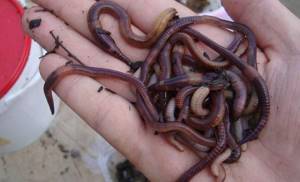
The favorite delicacy of bream is a bunch of dung worm, with the use of which you should start any fishing . More spoiled by the availability of available food in the summer, bream switches to vegetable baits and in such seasons they successfully use boiled new potatoes, pearl barley, peas and canned sweet corn. Additives to plant baits for maggots and bloodworms almost always increase the chances of bites. Knowing that bream most readily takes bait from the bottom, bream fishermen have successfully introduced all sorts of boilies and pellets into this type of fishing. Mastyrka, hominy and bread crumb are also in demand in the diet of the bronze glutton, but practice shows that loose baits are inconvenient for fishing from the side of a boat on currents, which limits their use, although it does not exclude them from the list of promising baits.
Working bait for bream
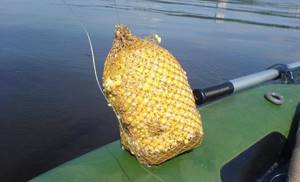
Groundbait is prepared on a base of breadcrumbs and fish feed, adding animal and plant components, as well as attractants, to the mixture. The animal component is formed from small bloodworms and canned maggots, the use of which prevents the larvae from spreading from the feeding spot. Boiled porridges are herbal additives, in particular millet, pearl barley and rolled oats. Crumpled sweet corn and sunflower cake added to the feeding mixture are a good addition to the feeding mixture. Attractants such as purchased essences of sweet tastes and natural ingredients in the form of molasses and cocoa are included in complementary foods based on the preferences of the bream in a particular place.
Important! The composition is made thick by compressing the bait into large balls, which should lie on the bottom without destruction in the water column, creating a compact zone at a certain point. Feeding is done once, in large quantities, since subsequent feedings will scare away the fish that come to the table for a long time.
Line, hook, fishing rod leash for bream
I equip the spools of the reels of onboard fishing rods for catching bream on a strong river current from a boat with reserves of medium-hard fishing line with a diameter of 0.22-0.25 mm. I tie the veins of soft fishing line leashes 10-15 percent thinner.
For fishing in clear river water, it is advisable to paint the line of the leash of a side fishing rod either to match the color of the bottom or to match the color of algae. For catching bream in muddy Russian rivers, the color of the fishing line and the end hooks of the bottoms are not particularly important.
Hook numbers - from No. 5 to No. 7 (according to Russian numbering) depend on the size and shape of the nozzles. In the summer we catch bream from boats using maggot and pearl barley. Then I tie hooks with a long shank ending in a ring to the leashes of the lines of the side fishing rods.
Hooks with spatulas are more suitable for making jigs, including “Uralochkas” - most suitable for catching bream on strong river currents with donks from a boat.
And it’s easier and faster to attach hooks with rings to the fishing lines of side fishing rods. A knot for tying a hook to a fishing line can be used as simple as a “Canadian figure eight”.
Fishing technique and tactics
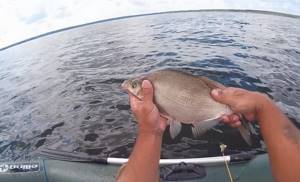
It is advisable to load the selected promising place with bait for a couple of days before fishing so that the bream gets used to the taste and the fishing point itself. Immediately before fishing, intensive feeding is done. Already after half an hour or two after casting the bait, the bites should begin. Bream bites are indicated by actions in which the float rests on the water, and the nod rises to the top; the guard for the bottom fishing rod makes a continuous sound. Any of these signals require the angler to set the hook immediately.
Having felt the severity of the catch of the trophy, they begin to carefully fish, trying to loosen the line or move the rod in the direction of the fish's movement when there is strong resistance, reeling in or lifting the rod when they feel a weakening of the pull. They try to bring the bream to the surface of the water, giving it a breath of air, after which it is pacified and gets into the boat with a net. The best fishing time is early morning, with the sky still twilight. On sunny and especially hot days, bream is less active. On cloudy, warm days with light rain and medium waves, the bite is more intense.
Choosing a place and searching for bream in a pond
An important factor in this method of catching bream is the correct selection of the fishing area. If you fish in shallow areas of reservoirs, then this fishing will be more catchy at night, and during the day the bream may be afraid of the presence of the boat itself.
For daytime fishing, you should select areas of reservoirs in which the water depth is more than three meters. Favorite habitats for bream are always stingrays with underwater hills, all kinds of holes and ravines at the bottom. At the same time, bream prefer clay-type surfaces of the bottom of the reservoir. Bream may be located near weak currents.

